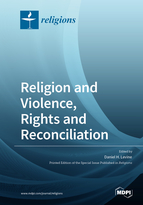Religion and Violence, Rights and Reconciliation
A special issue of Religions (ISSN 2077-1444).
Deadline for manuscript submissions: closed (30 September 2020) | Viewed by 20736
Special Issue Editor
Interests: religion, society and culture; human rights, violence and religion; religion and politics; liberation theology; Latin American politics, democracy and democratization; civil society, cultural change
Special Issues, Collections and Topics in MDPI journals
Special Issue Information
Dear Colleagues,
The long history of entangled relations between religion and violence are visible across a wide range of cultures, religious traditions, and historical eras. Religious individuals, groups, and institutions have been both victims and perpetrators of violence. They have rallied to action (through protests, civil conflicts, and wars) and seek to engage with opposing religions, to support or oppose existing states and social orders, or to advance or enforce policy agendas. The influence is not just one way; political or dynastic authorities of all kinds have also reached out to religions, not only mobilizing them for support and legitimation, but also to suppress or marginalize in particular situations.
Examples abound: Christian crusaders and Muslim Jihadists, the Muslim-Hindu struggles in India, the Cristero wars in early 20th century Mexico, anti-abortion bombers, Catholic groups and institutions in the Rwandan genocide, right- and left-wing Catholics in modern Latin America. Even groups famed for pacifism, like Buddhist monks, have taken up arms, for example, in the Sri Lankan civil wars.
Attention to the mutual impact of religion and violence should not obscure important strains of religiously inspired nonviolence. Nonviolence is both a personal and group belief and a tactic for opposing entrenched power. Pacifists like Quakers and Mennonites also provide mediation and neutral spaces for conflict resolution. Notable modern instances of nonviolence as a moral imperative and a tactic include the U.S. civil rights movement (grounded in the African American churches), the Indian experience of nonviolent resistance to British rule inspired by Gandhi, peace and rights activists in the last days of the East German communist regime, and the anti-apartheid movement in South Africa. These experiences show that “passive resistance” is anything but passive. By their presence, nonviolent resisters challenge the legitimacy and efficacy of existing structures of power and mobilize moral authority for resistance.
The 20th century witnessed a surge of movements around the world that justify and defend human rights. The concept draws on long standing elements of natural rights in civil law and religion, with important links to religious organizational networks and resources. The root concept is that if all humans are children of God, reflecting divine care and images, then all are entitled to life. Religious ideas and networks were critical to the Civil Rights movement in the US, and to the consolidation of human rights networks in Latin America.
Comparable ideas of human rights and dignity have also inspired efforts at post-violence reconciliation, for example in numerous truth commissions whose agenda has been influenced and often supported by religious ideas, groups, and institutions.
The experience of religion with violence, rights, and reconciliation plays out on multiple social levels (local, regional, national, and transnational). It cannot be reduced to a single direction or mode, or frozen in time as if one experience defines all. These are dynamic relationships that call for theoretical reflection and empirical study.
Prof. Dr. Daniel H. Levine
Guest Editor
Manuscript Submission Information
Manuscripts should be submitted online at www.mdpi.com by registering and logging in to this website. Once you are registered, click here to go to the submission form. Manuscripts can be submitted until the deadline. All submissions that pass pre-check are peer-reviewed. Accepted papers will be published continuously in the journal (as soon as accepted) and will be listed together on the special issue website. Research articles, review articles as well as short communications are invited. For planned papers, a title and short abstract (about 100 words) can be sent to the Editorial Office for announcement on this website.
Submitted manuscripts should not have been published previously, nor be under consideration for publication elsewhere (except conference proceedings papers). All manuscripts are thoroughly refereed through a double-blind peer-review process. A guide for authors and other relevant information for submission of manuscripts is available on the Instructions for Authors page. Religions is an international peer-reviewed open access monthly journal published by MDPI.
Please visit the Instructions for Authors page before submitting a manuscript. The Article Processing Charge (APC) for publication in this open access journal is 1800 CHF (Swiss Francs). Submitted papers should be well formatted and use good English. Authors may use MDPI's English editing service prior to publication or during author revisions.






